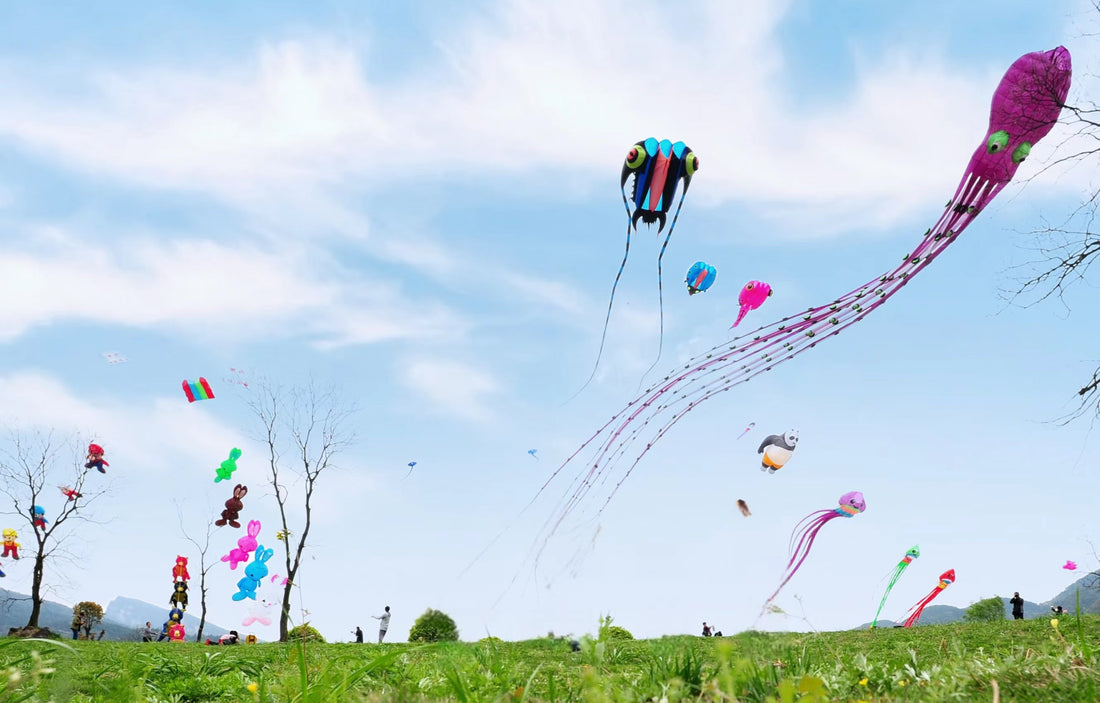
Flying Kites Together on Double Ninth Festival
Share
Flying kites during the Double Ninth Festival is a cherished tradition in Chinese culture that symbolizes aspirations and a deep connection with nature. The Double Ninth Festival, also known as Chongyang Festival, falls on the ninth day of the ninth month in the lunar calendar. This festival is a time when people ascend to higher grounds, such as mountains or tall towers, to ward off bad luck and embrace good fortune. The practice of kite flying during this festival enhances the experience of "climbing high" by allowing participants to send their wishes skyward through the medium of paper kites. Historically, kites were seen as vessels that could carry one's troubles away or deliver messages to ancestors and deities. The kite, or 纸鸢 (zhǐ yuān) in Chinese, holds significant cultural symbolism, representing freedom, joy, and the human desire to soar to new heights. The sky filled with colorful kites during the Double Ninth Festival creates a picturesque scene that embodies the spirit of the festival and the harmonious relationship between humans and nature.

The making of traditional kites is an intricate art that reflects the craftsmanship and creativity of Chinese folk artisans. The process of kite making begins with selecting the appropriate materials, traditionally using bamboo for the frame due to its flexibility and strength. The bamboo is carefully split and shaped into the desired frame, which can range from simple geometric shapes to elaborate figures of dragons, birds, or mythical creatures. Paper kites are then crafted by pasting thin, lightweight paper or silk onto the frame, creating a canvas for artistic expression. Artisans paint the kites with vibrant colors and intricate designs, often depicting symbols of good luck, prosperity, and longevity. The tail of the kite is an essential component, providing stability and balance during flight, and is often adorned with ribbons or additional decorations. The craftsmanship involved in traditional kite making is not merely a hobby but a respected folk art that has been passed down through generations. It embodies cultural values, aesthetic principles, and an understanding of aerodynamics that allow these kites to take flight gracefully. Workshops and communities dedicated to preserving the art of kite making play a crucial role in keeping this aspect of cultural heritage alive, especially during festivals like the Double Ninth Festival.


In contemporary times, a wide variety of kites have emerged, showcasing innovation while preserving traditional elements. Modern kites come in countless shapes and sizes, reflecting both technological advancements and creative exploration. From delta and diamond-shaped kites to more complex designs like parafoils and box kites, enthusiasts have a plethora of options to choose from. Various kites now incorporate themes from popular culture, including characters from movies, cartoons, and even abstract art forms. Materials have expanded beyond traditional bamboo and paper to include fiberglass, carbon fiber, nylon, and polyester fabrics, enhancing durability and performance. Stunt kites and power kites have gained popularity, offering dynamic flying experiences that involve acrobatics and even kite surfing. Despite these innovations, many modern kite designs still pay homage to traditional aesthetics by incorporating classic Chinese motifs and craftsmanship techniques. Festivals around the world feature competitions and exhibitions where these innovative kites are showcased, highlighting the global influence of Chinese kite culture. The diversity of kites available today reflects a fusion of tradition and modernity, allowing the timeless joy of kite flying to be experienced in new and exciting ways during the Double Ninth Festival and beyond.


Improved kites incorporate advanced materials and technology, enhancing performance and diversifying kite flying experiences. The development of improved kites has been driven by a desire for better flight stability, maneuverability, and ease of use. High-tech materials like carbon fiber rods provide lightweight yet robust frames, while ripstop nylon fabrics resist tearing and withstand various weather conditions. Aerodynamic designs have been refined using wind tunnel testing and computer modeling, resulting in kites that can achieve greater heights and perform complex stunts. Some advanced kites are equipped with LED lights for night flying, adding a dazzling visual element to festivals and events. Others are designed for specific purposes, such as traction kites used in sports like kiteboarding and land kiting, harnessing wind power for propulsion. Innovations like adjustable bridles and control systems give flyers precise command over their kites, making the activity more accessible to beginners and more challenging for seasoned enthusiasts. These technological advancements have transformed kite flying from a leisurely pastime into a sophisticated sport and art form. The evolution of kite technology exemplifies how traditional practices can adapt and thrive in the modern era, enriching cultural celebrations like the Double Ninth Festival with enhanced experiences.

Traditional folk crafts related to kites enrich the cultural heritage associated with kite flying during the Double Ninth Festival. Beyond the act of flying, the creation and appreciation of kite folk crafts play a significant role in Chinese culture. Artisans specialize in crafting miniature kites as decorative pieces, incorporating techniques like paper cutting, embroidery, and painting. These small-scale kites often serve as souvenirs or gifts that carry cultural significance and personal sentiments. Workshops teaching traditional kite arts are popular during the Double Ninth Festival, providing hands-on experiences where participants can learn about the history, symbolism, and techniques of kite making. Such activities promote the preservation of intangible cultural heritage and foster intergenerational connections. Additionally, related crafts like making wind chimes, paper lanterns, and kite-inspired calligraphy contribute to the festive atmosphere. In some regions, performances featuring kites are held, where skilled practitioners demonstrate acrobatic flying or storytelling through kite displays. These events highlight the communal aspect of the festival, bringing people together to celebrate shared traditions. The integration of kite culture into various forms of folk art underscores the multifaceted significance of kite flying in Chinese society. It is not merely a recreational activity but a conduit for cultural expression, education, and unity during the Double Ninth Festival and throughout the year.





